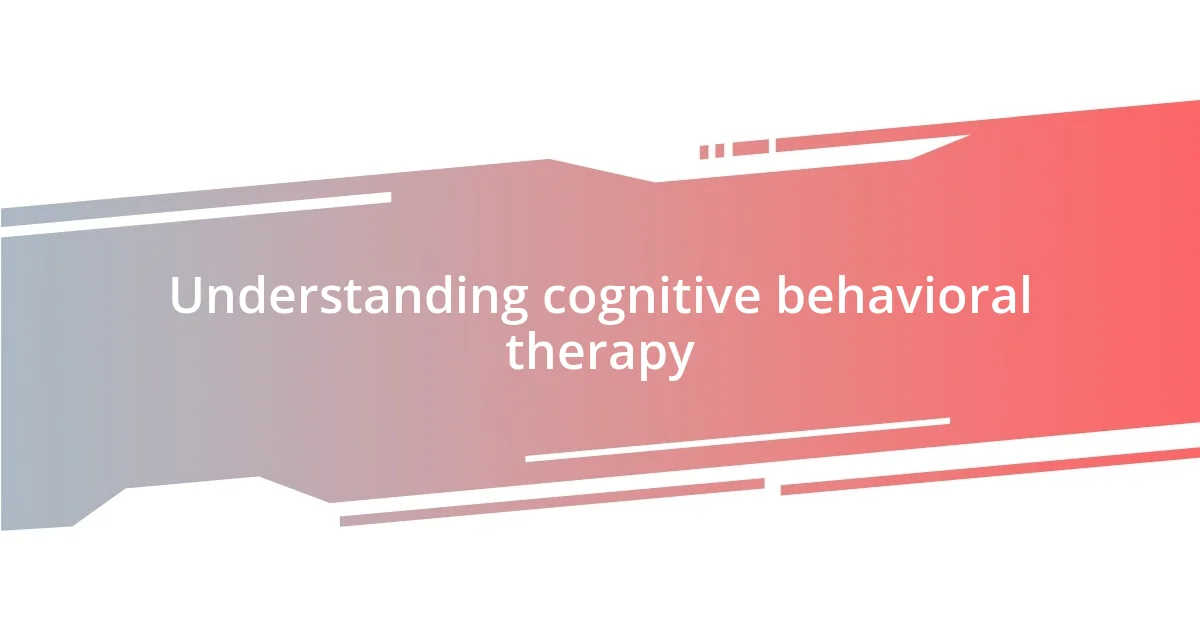Key takeaways:
- CBT emphasizes the connection between thoughts, feelings, and behaviors, enabling individuals to challenge and reframe negative thought patterns.
- Key benefits of CBT include increased awareness of thought patterns, practical strategies for managing anxiety, and fostering emotional resilience in the face of setbacks.
- Effective CBT requires active participation, consistent effort, and pre-session preparation to deepen discussions and enhance the therapeutic experience.

Understanding cognitive behavioral therapy
Cognitive Behavioral Therapy, or CBT, is all about understanding the connection between our thoughts, feelings, and behaviors. When I first encountered CBT, I was struck by how simple yet profound its core principle is: our thoughts directly influence how we feel and act. Have you ever noticed how a negative thought can spiral into a bad mood that affects your entire day? That’s the essence of CBT, and recognizing this relationship was a game-changer for me.
At its heart, CBT teaches us to identify and challenge negative thought patterns. I remember a time when I felt overwhelmed by self-doubt before a big presentation. Through CBT techniques, I learned to reframe my thoughts, transforming “I’ll probably fail” into “I’ve prepared well and can handle this.” This shift didn’t just lessen my anxiety; it empowered me to perform better.
But what makes CBT so effective is its structured approach. It doesn’t just explore why we think the way we do; it provides tangible tools to change those thoughts. For instance, journaling about my daily thoughts revealed patterns I had long overlooked. I began to ask myself, “What evidence do I have for these thoughts?” This introspection—not only enlightening but also affirming—was instrumental in reshaping my mindset.

Benefits of cognitive behavioral therapy
CBT offers numerous benefits that can significantly improve one’s mental health. One of the standout advantages for me has been the increased awareness of my thought patterns. By actively engaging in CBT, I started to notice not just negative thoughts but also the triggers behind them. For instance, when I began feeling anxious before outings, I learned to pause and ask myself why. This simple act of reflection was liberating; it helped me regain control over my emotions.
Another crucial benefit of cognitive behavioral therapy is its focus on practical strategies. I’ve found that tools like guided imagery and thought records can be game-changers in handling distressing situations. For example, there was a time when a looming deadline sent my stress levels soaring. Using a thought record, I systematically broke down my fears and unearthed the irrationality behind them. This process not only reduced my anxiety but also equipped me with strategies to tackle similar feelings in the future.
Moreover, CBT fosters a sense of resilience. I never realized how effectively it could help me bounce back from setbacks until I faced a personal disappointment. Instead of spiraling into frustration, I applied CBT techniques to re-evaluate my perspective. It became clear that each setback brought valuable lessons. This mindset shift has been integral in fostering my emotional resilience and enriching my overall approach to life’s challenges.
| Benefit | Description |
|---|---|
| Increased Awareness | Helps identify and understand negative thought patterns and triggers. |
| Practical Strategies | Equips individuals with tools to manage anxiety and irrational thoughts effectively. |
| Fostering Resilience | Encourages a positive perspective on setbacks and emotional growth. |

Preparing for your CBT sessions
Preparing for your CBT sessions requires a bit of mindfulness and intention. I’ve found that taking the time to reflect on my feelings and thoughts before each session really enhances the experience. It’s almost like warming up my brain for the work ahead. I often jot down any specific issues or thoughts I want to discuss, which gives me a sense of direction and purpose.
Here are some practical steps to consider as you prepare for your CBT sessions:
- Reflect on Recent Experiences: Think about situations that triggered strong emotions or negative thoughts since your last session.
- Identify Goals for Each Session: Define what you hope to achieve during your upcoming meeting. This could be understanding a particular thought pattern or developing coping strategies.
- Practice Self-Compassion: Remind yourself that it’s okay to feel vulnerable. Embracing your feelings is a crucial part of healing.
- Gather Materials: Bring along any thought records or journals you’ve worked on. They can serve as valuable tools to track your progress.
- Consider Questions: Think of any questions or doubts you want to address with your therapist, which can lead to richer discussions.
As I transitioned into the practice of CBT, I made it a ritual to spend a few quiet moments reflecting before my sessions. I remember one time feeling particularly anxious about an upcoming family gathering. I wrote down my worries and traced them back to an old belief that I wasn’t good enough. This reflection sparked a deeper discussion with my therapist, helping me challenge that belief effectively. Often, this pre-session reflection not only enriches the therapy experience but also strengthens my commitment to change.

Common misconceptions about CBT
When it comes to cognitive behavioral therapy (CBT), one of the most common misconceptions is that it’s a quick fix for mental health issues. People often expect immediate results, but that’s not how CBT works. From my experience, real change takes time and consistent effort. It’s about gradually unlearning negative thought patterns and replacing them with healthier ones, much like training for a marathon rather than just sprinting a mile.
Another misconception I’ve encountered is the belief that CBT is solely about positive thinking. While cultivating a positive mindset is certainly a component, it’s much deeper than that. I remember a session when my therapist guided me through the process of identifying not just my negative thoughts, but also the underlying beliefs that fueled them. This realization was pivotal! By addressing the roots of my anxieties, I was able to engage with my feelings on a more profound level rather than just plastering over them with positivity.
Lastly, some people think CBT is a passive process where the therapist simply tells you what to do. In reality, it requires active participation. I once resisted this idea, expecting my therapist to provide all the answers. However, I soon realized that my role was crucial—I had to reflect on my thoughts, challenge them, and develop strategies. This collaboration transformed my experience, allowing me to take ownership of my mental health journey. Have you ever felt like you’re waiting for someone else to “fix” your problems? I’m here to tell you that embracing your agency through CBT can be incredibly empowering!

Tips for maximizing CBT effectiveness
One of the most effective ways to maximize the benefits of CBT is to actively engage in the homework assigned by the therapist. I recall a time when I was hesitant about completing my homework. It felt tedious, but committing to those exercises offered me clarity about my triggers. What I learned is that these tasks solidify what we discuss in therapy, allowing me to practice outside of sessions—making real-world applications that much easier and reinforcing the concepts we worked on.
Another tip is to be open and honest during sessions. It might feel uncomfortable at times, especially when discussing sensitive topics. I remember sharing an embarrassing moment that led to feelings of inadequacy. Initially, I wanted to brush it aside, but confronting those feelings opened a door to deeper understanding. The more transparent I was, the more my therapist could tailor the approach to my unique situation. So, ask yourself: Are you holding back any thoughts or emotions? Tapping into that vulnerability can lead to transformative breakthroughs.
Additionally, fostering a consistent routine can greatly enhance the effectiveness of CBT. I’ve found that scheduling my therapy sessions at the same time each week helped establish a rhythm. It became part of my self-care routine, much like going for a walk or reading a good book. On days I felt overwhelmed, I could look forward to those sessions as a time to unload and reflect. This habitual practice reinforced my commitment to the therapeutic process, instilling a sense of accountability. Have you considered how a routine might support your journey? It’s worth exploring.













